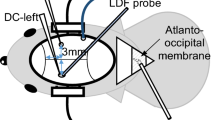Summary
The Electroencephalogram (EEG) of 151 patients whose ruptured aneurysm was confirmed by CT scan and angiography was recorded on the first day (D1) and the fifth day (D5).
On D1, EEG had a prognostic value: among 46 patients with normal EEG, 72% presented neither further electrical ischaemic features nor delayed angiographic vasospasm; on the other hand, when bilateral bursts of slow waves, “axial bursts” or slow delta waves were recorded (78 cases), 97% exhibited EEG signs of ischaemia and angiographic vasospasm a few days later. These data were clearly related to the importance of the haemorrhage, specially when thick clots in the subarachnoid cisterns were found on the CT scan.
On D5, EEG had a diagnostic value: focal or asymetrical bilateral delta waves occuring at that date seemed to correspond to ischaemia; among 107 patients with these electrical features, an angiographic vasospasm appeared in 96% of cases, and the importance of electrical abnormalities could be related to the degree of arterial narrowing.
We conclude that EEG data are very useful in prediction as well in recognition of post-subarachnoid haemorrhage ischaemia due to vasospasm and are sufficiently precise to postpone control angiography and operation, when delayed surgery is programmed.
Similar content being viewed by others
References
Allcock JM, Drake CG (1965) Ruptured intracranial aneurysms. The role of arterial spasm. J Neurosurg 22: 21–29
Arbus L, Lazorthes Y, Campan L, Rouquie P, Grezes-Rueff C (1977) L'EEG pré-operatoire dans les anévrismes cérébraux rompus. Intérêt de la compression carotidienne et du test d'hypotension contrôlée. Rev Electroenceph Clin Neurophysiol 7: 165–169
Beattry RA, Richardson AE (1969) The value of electroencephalography in the management of multiple intracranial aneurysms. J Neurosurg 30: 150–153
Clifford-Rose MF (1964) L'EEG dans l'anévrisme intra-crânien rompu. Rev Neurol (Paris) 111: 383–385
Dabbah M, Le Beau J (1964) L'EEG dans les anévrismes de la communicante antérieure. Sem Hôp Paris 48: 2615–2617
Fischer CM, Roberson GH, Ojemann RG (1977) Cerebral vasospasm after ruptured aneurysms: a clinico-radiologic correlation. Stroke 8: 11
Fischer CM, Kistler JP, Davis JM (1980) Relation of cerebral vasospasm to subarachnoid haemorrhage visualized by computerized tomographic scanning. Neurosurgery 6: 1–9
Geraud G, Andrieu P, Guell A, Tremoulet M, Bes A (1985) Débit sanguin cérébral et hémorragie méningée. Rev Neurol (Paris) 141: 371–378
Grezes-Rueff C, Arbus L, Lazorthes Y (1972) La valeur de l'EEG dans la surveillance des hémorragies par anévrismes rompus. In: Geraud G, Lazorthes G, Bes A (eds) L'ischémie cérébrale dans le territoire carotidien. Imprimerie Fournié, Toulouse, pp 189–194
Hanau J, Foncin JF, Le Beau J (1969) Sur le rôle de l'ischémie cérébrale dans l'évolution fatale des ruptures anévrismales su-pra-tentorielles. Neurochirurgie 15: 353–368
Hijdra A, Van Gijn J, Stefanko S, Van Dongen KJ, Vermeule M, Van Crevel H (1986) Delayed cerebral ischaemia after aneurysmal subarachnoid haemorrhage. Neurology (NY) 36: 329–333
Kistler JP, Corwell RM, Davis KR, Heros R, Ojemann RG, Zervas T, Fischer CM (1983) The relation of cerebral vasospasm to the extent and reaction of subarachnoid blood visualized by CT scan: a prospective study. Neurology (NY) 33: 424–436
Landau-Ferey J, Rivierez M, Gaches J, Phillippon J (1984) Apport de l'électro-encéphalogramme au diagnostic de vasospasme après rupture d'anévrisme intracrânien. Neurochirurgie 30: 25–29
Millar JHD (1953) The electroencephalogram in cases of subarachnoid haemorrhage. Rev Electroencephalogr Clin Neurophysiol 5: 165–168
Mizukami M, Takemae T, Tazawa T, Kawase T, Matsuzaki T (1980) Value of computed tomography in the prediction of cerebral vasospasm after aneurysm rupture. Neurosurgery 7: 583–586
Mourier K, George B, Raggenau JL, Dematons C, Luft A, Gelbert F, Cophignon J (1988) Intérêt de la mesure du débit sanguin cérébral dans le choix de la date opératoire des anévrysmes intra-crâniens rompus. Neurochirurgie 34: 304–310
Nau HE, Bock WJ (1979) Value of electroencephalography before and after surgery of intracranial aneurysms. Acta Neurochir (Wien) 47: 45–52
Niizuma H, Kwak R, Otabe K, Suzuki J (1979) Angiographic study of cerebral vasospasm following the rupture of intracranial aneurysms: part II: relation between the site of aneurysm and the occurrence of the vasospasm. Surg Neurol 11: 263–267
Rivierez M, Dagreou F, Guggiari M, Ankri A, Crespo B, Philippon J (1983) Intérêt pronostique de l'activité fibrinolytique du LCR dans les hémorragies méningées par rupture anévrysmale. Neurochirurgie 29: 119–123
Robert G, Sichez JP, Pertuiset B, Gardeur D (1981) Hémorragie méningée par rupture anévrismale: la tomodensitométrie précoce permet-elle de prévoir l'apparition du spasme? Neurochirurgie 27: 129–131
Saito I, Sano K (1980) Vasospasm after aneurysm rupture. Incidence, onset and course. In: Wilkins RH (ed) Cerebral arterial spasm. Williams and Wilkins, Baltimore, pp 294–301
Sundt TM (1976) Cerebral vasospasm following subarachnoid haemorrhage: evolution, management and relationship of timing of surgery. Clin Neurosurg 24: 228–239
Supino-Viterbo S, Hanau J (1973) Corrélations électro-anatomiques dans les complications ischémiques des anévrismes de la communicante antérieure rompus. In: Geraud J, Lazortes G, Bes A (eds) L'ischémie cérébrale dans le territoire carotidien. Imprimerie Fournié, Toulouse, pp 189–193
Suzuki J, Komatsu S, Sato T, Sakurai Y (1980) Correlation between CT findings and subsequent development of cerebral infarction due to vasospasm in subarachnoid haemorrhage. Acta Neurochir (Wien) 55: 63–70
Author information
Authors and Affiliations
Rights and permissions
About this article
Cite this article
Rivierez, M., Landau-Ferey, J., Grob, R. et al. Value of Electroencephalogram in prediction and diagnosis of vasospasm after intracranial aneurysm rupture. Acta neurochir 110, 17–23 (1991). https://doi.org/10.1007/BF01402042
Issue Date:
DOI: https://doi.org/10.1007/BF01402042




